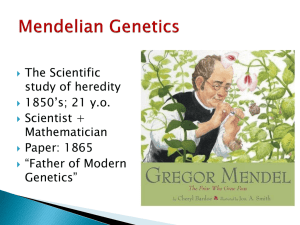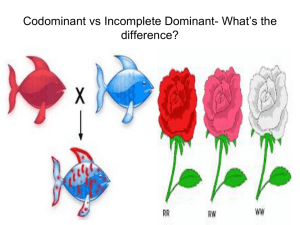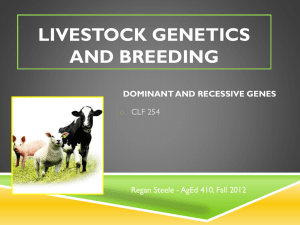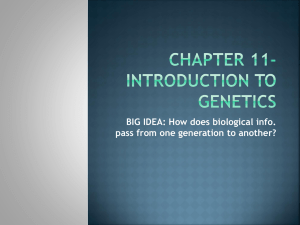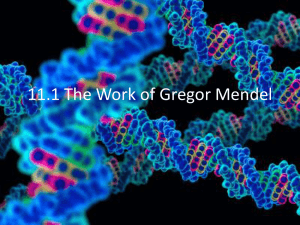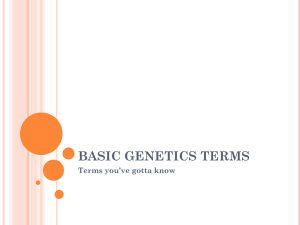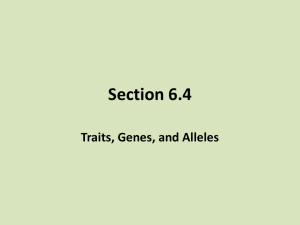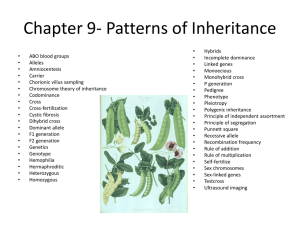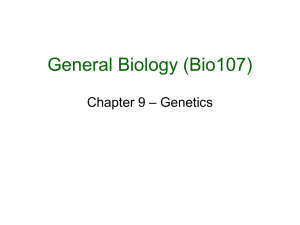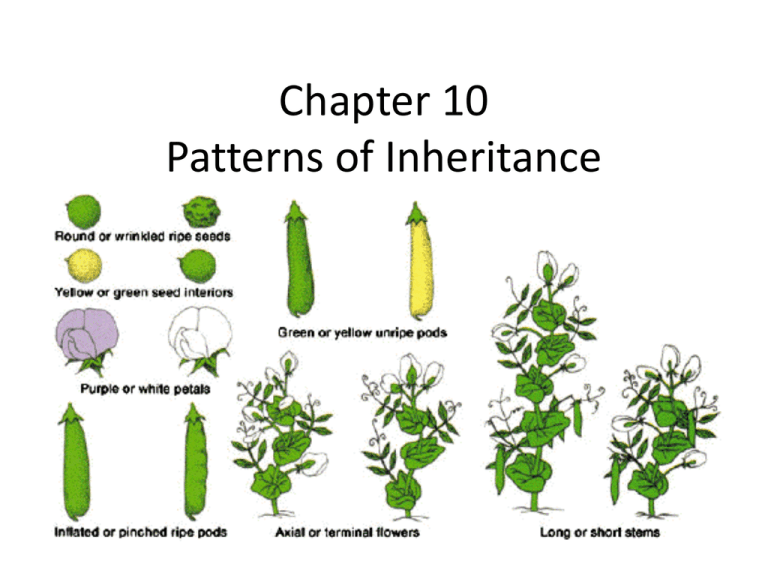
Chapter 10
Patterns of Inheritance
Genetics
• Genetics is the branch of science that studies
how the characteristics of living organisms are
inherited.
– In classic or Mendelian genetics, the central
question is how are characteristic seen in parent
distributed among offspring.
Alleles
• An allele is a specific version of a gene.
– Examples: eye color, hair color, earlobe type
• The two different alleles are on the same part
of a chromosome
Fundamentals of Genetics
• The interaction of alleles determines the
appearance of the organism.
– The genotype of an organism is the combination of
alleles that are present in an organism’s cells
• Ex. BB, Bb, bb
• Homozygous – two identical alleles
• Heterozygous – two different alleles
– The phenotype of an organism is how it appears
outwardly and is a result of an organism’s genotype
• Blue eyes, brown eyes
Fundamentals of Genetics
• A dominant allele masks the recessive allele in
the phenotype of an organism
– Dominant allele is usually shown by a capital letter
– Recessive alleles are usually shown by a lowercase letter.
•
•
•
•
B – brown-eyes, b – blue-eyes
BB
Bb
bb
Fundamentals of Genetics
• Genetic cross is a planned mating between
two organisms
– Punnett square shows the possible offspring of a
particular genetic cross
• Aa x Aa
Punnett Square
• Earlobes: E=free, e=attached
EE x ee
Ee x Ee
EE x Ee
EE:
Ee:
ee:
EE:
Ee:
ee:
EE:
Ee:
ee:
The Father of Genetics
• Gregor Mendel (1822-1884)
• Mendel was an Augustian monk in
the Czech Republic.
• He studied physics and botany at
the University of Vienna.
• He worked for 12 years on his
genetic experiments and published
them in the local natural history
journal in 1866.
• Mendel’s results were forgotten
until the early 20th century.
Pea Plants
• Mendel performed experiments concerning
the inheritance of seven certain characteristics
of pea plants.
Pea Plants
• Mendel had one pure breeding purple and
one pure breeding white flower plant and
crossed them. This generation, is known as
the Parental, or P.
• CC x cc
Pea Plants
• As seen in the previous slide, all the offspring
of the P generation resulted in a purple color,
with a genotype of Cc. This generation is
known as the F1 generation. Mendel allowed
the F1 generation to self-fertilize.
• This results in the F2 generation.
Mendel
• Mendel recognized four genetic principles
– Organisms have two pieces of genetic information
for each trait (later called alleles)
– Law of Dominance states that some alleles
interact with each other in a dominant and
recessive manner, where the dominant allele
masks the recessive trait
– Gametes fertilize randomly
– Law of Segregation says when a diploid organisms
forms gametes, the two alleles for a characteristic
separate from one another.
Single-Factor Cross
• Let’s try a single-factor cross of our own now
– Two heterozygous for pod color; Green is
dominant and yellow is recessive
Double-Factor Cross
• Genes on non-homologous chromosomes are
inherited independently.
• Step 1) One parent has yellow, round seeds (YYRR)
and the other has green, rough seeds (yyrr).
Seed
color yellow
(Y)
Seed
color yellow
(Y)
Seed
shape round (R)
Seed
shape round (R)
Seed
color green (y)
Seed
color green (y)
Seed shape
- rough (r)
Seed shape
- rough (r)
Double-Factor Cross
• To predict the number of different gametes,
use 2n where n = # of heterozygous genes on
non-homologous chromosomes.
• In this case, 22 = 4 different gametes.
Seed
color yellow
Seed
color green
• Gamete Possibilities:
Seed
shape round
Seed shape
- rough
Double-Factor Cross
• Time for the Punnett Square for F1
Double-Factor Cross
• Now lets do an F2 generation of heterozygous
(YyRr)
• Possible gametes:
Double-Factor Cross
• Time for the Punnett Square for F1
Double-Factor Cross
Human Traits – Dominant or Recessive
• Cleft in chin - No cleft dominant, cleft
recessive
• Widow peak dominant, straight hairline
recessive
• Free lobe dominant, attached recessive
• Freckles dominant, no freckles recessive
• Roller dominant, nonroller recessive
Autosomal Dominant Traits: Polydactyly
• Polydactyly is the appearance of more than the
normal number of digits on the hand or the foot.
• While the overall frequency is 1 in 500 births, it is
more common in some populations (e.g., Amish in
U.S.).
• Polydacytly is the result of an autosomal dominant
genetic trait.
Autosomal Dominant Traits: Polydactyly
• What will the children look like if one parent is a
heterozygous polydactylous parent and other is a
“normal” pentadactylous parent?
6
5
5
5
• The chance that any child will be polydactylous (65) is
50:50.
• The chance that any child will be pentadactylous (55) is
50:50.
Autosomal Recessive Traits: Phenylketonuria
Fig. 10.4, pg.
200
• Phenylketonuria (PKU) is caused by a mutation on
chromosome 12 which prevents the synthesis of an
enzyme which degrades phenyalanine, an amino
acid.
Autosomal Recessive Traits: Phenylketonuria
• Phenylketonuria appears in 1 in every 17,000
births.
• Phenylketonuria is an autosomal recessive
trait.
• Only individuals who are homozygous
recessive (2 copies of the phenylketonuria
allele) will have this disorder.
• Because heterozygotes have one normal copy
of the gene which makes the key enzyme, they
will not show the disorder
• Heterozygous individuals are called carriers.
Autosomal Recessive Traits: Phenylketonuria
• What will the children look like if two parents are both
carriers of the phenyketonuria?
• The chance that any child will be totally free of the
disorder (NN) is 25%.
• The chance that any child will be a carrier (Nn) is 50%.
• The chance that any child will have phenyketonuria
(nn) is 25%.
Complete Dominance
• In the genes that Mendel
examined, one allele
demonstrated complete
dominance.
• In heterozygotes, the
dominant allele was
expressed in the phenotype
and the alternative allele
(recessive) was repressed.
• An individual with a
dominant phenotype could
have either a homozygous
dominant genotype (PP) or
a heterozygous genotype
(Pp).
Incomplete Dominance
• In other genes, a
heterozygous individual
has a phenotype that is
intermediate.
• A heterozygous
snapdragon CRCW is pink.
• F2 offspring of P1
homozygous cross will
show three phenotypes
and genotypes in a 1:2:1
ratio.
Incomplete Dominance
• Let’s do a Punnett Square for Incomplete
Dominance. FRFW x FWFW
Genotype
Phenotype
FWFW
White Flower
FWFR
Red Flower
FRFW
Pink Flower
Codominance
• In codominance the effects of both alleles are
visible as distinct effects on the phenotype.
• Like incomplete dominance, the F2 offspring
of a monohybrid cross of two codominant
alleles will lead to 3 types of offspring with 3
genotypes in a 1:2:1 ratio.
• A good example of codominance is expression
of the A and B blood type alleles in humans.
Codominance
• Multiple Alleles refers to situations in which
there are more than 2 possible alleles that
control a particular trait
• For blood type there are three different alleles
– IA – blood has type A antigen on rbc surface
– IB – Blood has type B antigen on rbc surface
– i – Blood type O has neither type A nor type B
antigens on rbc surface
Interactions Among Alleles
• Type A blood has anti-B antibodies.
• Type B blood has anti-A antibodies
• Type O blood has no antibodies for A or B
Codominance
• Another Punnett Square for a child who has a
parent with type A blood and type O blood.
Codominance
• Type O individuals (ii) are universal donors and
type AB are universal recipients
Polygenic Inheritance
• The final phenotype may depend on the
additive effects of several genes.
Pleiotropy
• Pleiotropy occurs when the alleles from a
single gene have multiple phenotypic effects.
Linkage Groups
• A linkage group is a set of genes located on
the same chromosome.
– They will be inherited together
– Crossing-over may occur in prophase I of Meiosis
I, which may split up these linkage group
– A child can have gene combinations not found in
either parent alone
– The closer together two genes are to each other,
the less likely crossing over would occur
Autosomal and Sex Linkage
• Autosomes are chromosomes not directly
involved in sex detrmination
• Sex Linkage occurs when genes are located on
the chromosomes that determine the sex of
an individual
– The Y chromosome is shorter than the X
chromosome and has few genes for traits found
on the X chromosome
– So, the X chromosome has many genes for which
there is no matching gene on the Y chromosome
Sex Linkage
• Males have both a Y chromosome with a few
genes on it and the X chromosome has many
of the recessive characteristics present on the
X chromosome appear more frequently in
males than females.
– X-linked genes are only found on the X
chromosome
– Y-linked genes are only found on the Y
chromosome
Sex Linkage
• Color-Blindness
Sex Linked
• Color Blindness
Allele Symbols
Possible Genotypes
Phenotypes
XB = normal color vision
Xb =color-deficient vision
Y= no gene for color vision
Females (XBXB or XBXb)
Males (XBY)
Female with normal color vision
Male with normal color vision
Females(XbXb)
Female with color-defective
vision
Male with color-defective vision
Males (XbY)
Sex Linkage
• One last Punnett Square for a mother who is
homozygous for normal color vision, and a
father who is color-defective vision
Sex Linkage

